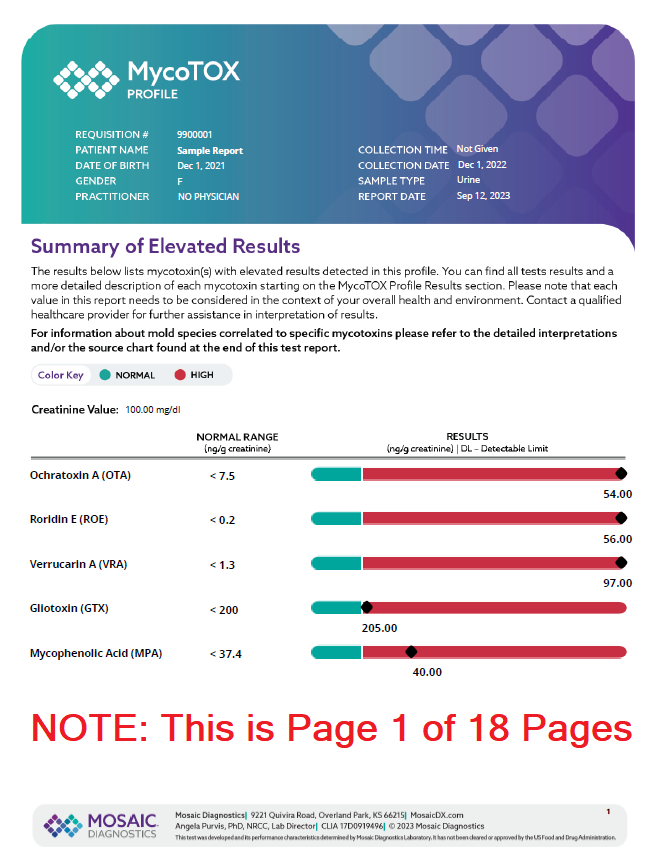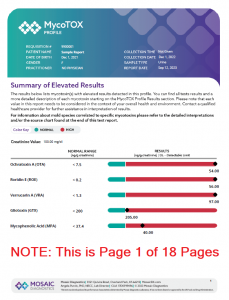Home / Shop
Mosaic MycoTOX Profile










- Description
- Specifications
- Customer Reviews (0)
Why Test for Mycotoxins?
Mycotoxins cause adverse health effects that may be acute and chronic in nature that can manifest in various and ambiguous symptoms, the degree of impact can vary depending on the age, sex, genetics, and underlying health status of the exposed individual, as well as the duration and dose magnitude of the offending substance and their synergistic effects with other mycotoxins. Providers assessing symptomatic patients with known mold exposure or with an environmental history concerning mold exposure, will also need to consider the concomitant presence of mycotoxins and their potential negative health impacts as proper testing is essential for accurate treatment. The MycoTOX Profile is specifically designed to help healthcare practitioners identify mycotoxin exposure and guide a targeted prevention and treatment plan.
NOTE: Your Mosaic Diagnostics MycoTox Profile report will be sent to the email used when ordering, unless otherwise specified. If you have further questions after receiving your report, a Telehealth Appointment with Dr. Ray Psonak is available.
FAQ's about At Home Health Tests
Turnaround Time: 1-2 weeks
Analytes
The MycoTOX Profile urine-based assay assesses levels of 11 different mycotoxins.
Below is a list of all all analytes included in the test along with a brief description.
Aflatoxins: AFM1
An aflatoxin of concern, AFM1, is a hydroxylated metabolite of AFB1 and is secreted in the milk of both humans and animals.
Ochratoxins: Ochratoxin A
Ochratoxin A (OTA) which is the most prevalent, toxic, and clinically relevant fungal toxin of this mycotoxin group. While it has been associated with numerous negative health impacts, the kidney has been noted to be its main target organ – and studies indicate its association with nephrotoxicity in humans and animals.
Trichothecenes: Roridin E (ROE), Verrucarin A (VRA),
Tricothecenes are extremely potent inhibitors of protein synthesis and have been described to have wide-ranging negative systemic effects including immunotoxicity (immunosuppression), gastrointestinal toxicity, neurotoxicity, and dermatologic manifestations.
Zearalenone: Zearalenone
The main toxic effect of Zearalenone relates to its endocrine disruptive capabilities and as such, resultant negative reproductive effects in humans and animals.
Chaetoglobosin (CHA)
Chaetomium globosum is frequently isolated from materials found in water-damaged buildings – and is often referred to as ‘black mold.’
Enniatin B (ENB)
ENB has been shown to have endocrine disrupting properties as well as the ability to cross the blood brain barrier in in vitro assays.
Gliotoxin (GTX)
Airborne Aspergillus fungal spores are ubiquitous in many environments making potential exposure to gliotoxin common. Gliotoxins have been found on linoleum flooring and wallpaper in water damaged buildings, as well as silage and other animal food stocks.
Mycophenolic Acid (MPA)
MPA is used as an immunosuppressive drug for the prevention of transplant rejection in the form of sodium mycophenolate (Myfortic™, Novartis) and a pro-drug, mycophenolate mofetil (CellCept™, Roche) – and as a result, its levels may be elevated on diagnostics in patients using these pharmaceuticals.
Sterigmatocystin (STC)
Sterigmatocystin is a precursor of aflatoxin B1 in fungi capable of producing aflatoxins. Despite the similarity of chemical structure of these two mycotoxins, Sterigmatocystin has been noted to be a less potent carcinogen than Aflatoxin B1 (AFB1). It is classified as a Group 2B carcinogen by the International Agency for Research on Cancer.
Citrinin (CTN)
Exposure to CTN has been linked to the development of nephropathy, which is caused by CTN’s ability to increase the permeability of mitochondrial membranes in the kidneys. Rat studies have demonstrated that CTN is carcinogenic. Furthermore, several studies have linked exposure to CTN with a suppression of the immune response.

2 thoughts on “Mosaic MycoTOX Profile”